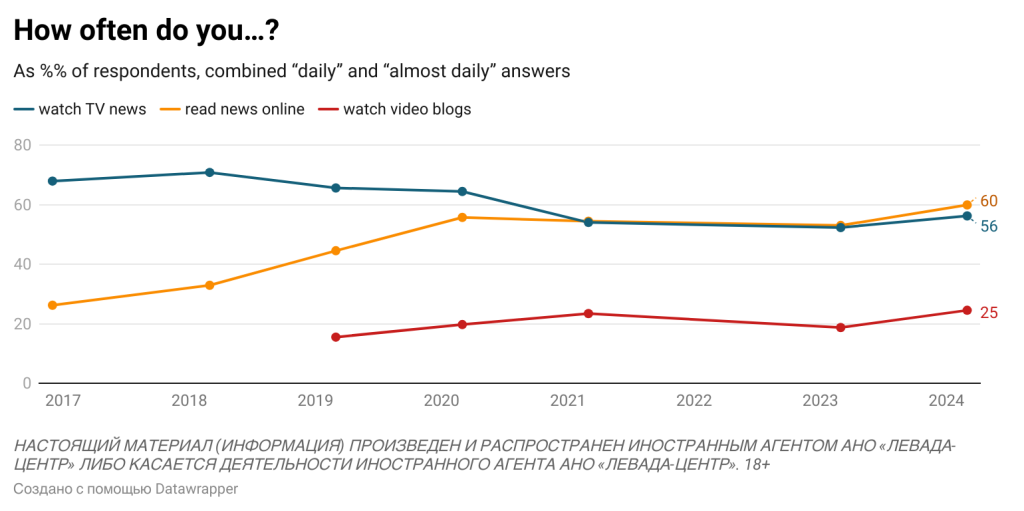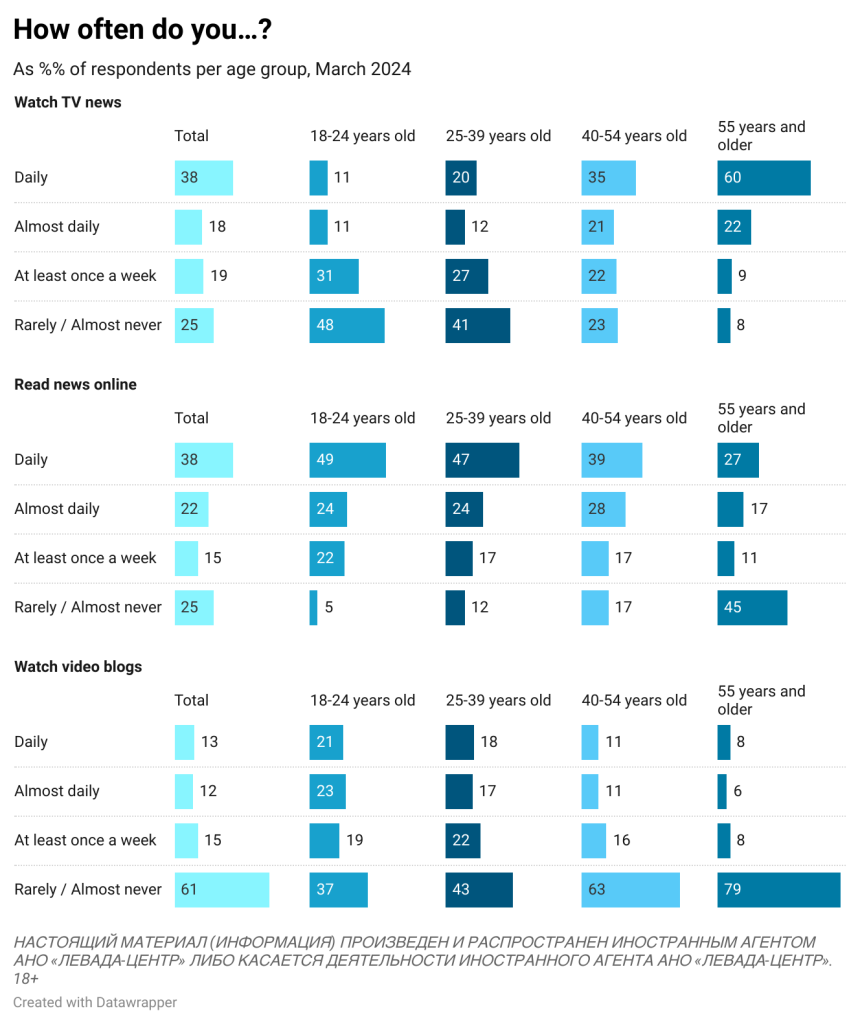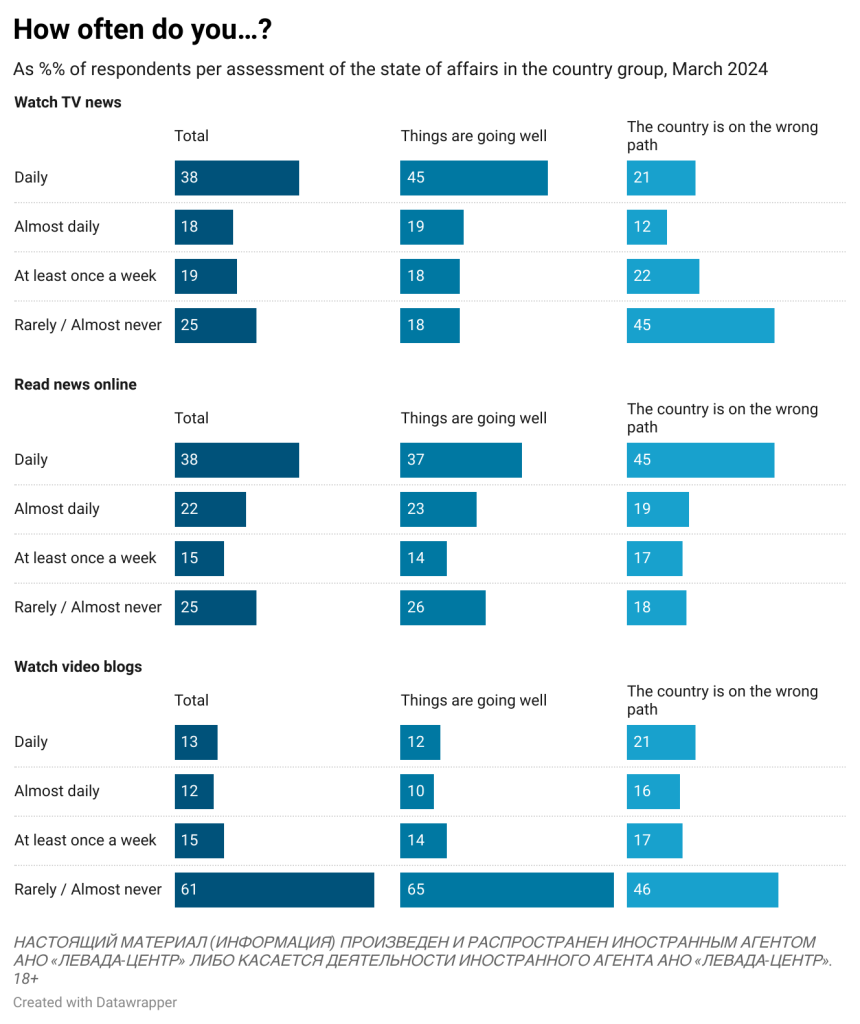Television remains the main source of information by audience reach and trust among Russians. At the same time, the combined audience of various news sources on the Internet exceeded the audience of TV news. Younger, educated and affluent respondents are more likely to get their news from the Internet. Older people, as well as less affluent and less educated respondents, are more likely to watch news on television. The audience of telegram channels has stabilized at the level of a quarter of the country’s population after a sharp increase in 2022. The audience of video blogs is slowly increasing, but the majority of respondents do not watch them. The most popular journalists, leading socio-political programs were V. Solovyov, O. Skabeeva, E. Popov, M. Simonyan and D. Kisilev. Independent bloggers and journalists are losing their audience.
Television remains the main source of news for Russians, so in March 2024, two thirds of Russians (65%) noted television as the main source of news. 38%, 28% and 24% of respondents usually find out information about events in the country and the world from social networks, online publications and Telegram channels, respectively. The audience of readers of telegram channels in 2023-2024 stabilized after a sharp increase in the spring of 2022.

The popularity of television as the main source of information is higher among older Russians, thus 85% of respondents aged 55 and older receive news from a television screen. Younger Russians are more likely to learn news from alternative sources: social networks (57%), Telegram channels (43%), as well as online publications (39%). TV is more popular among respondents with secondary education and below (69%), as well as those who barely have enough to eat (59%). Respondents with higher education (43%, 38%, 30%, respectively), as well as respondents who can afford durable goods (TV, refrigerator, car, etc.) consume news from social networks, Internet sources and telegram channels more often than others – 42%, 35%, 31%, respectively.



The level of confidence in TV is gradually recovering after a slight decline in the spring of last year. Every second respondent trusts news on television, Internet publications and social networks, 16% and 18% of respondents each. The trust of telegram channels also continues to grow, now they are coming in second place in terms of trust in news coverage, in March of this year they were trusted by 18% of respondents.

The trust towards TV news coverage in the country and in the world depends on the age of the respondents. Older respondents (66% aged 55 and over), respondents with secondary education and below (55%), and those who barely have enough money for food (59%) are more likely to trust television news.
The level of trust in social networks, telegram channels and online publications is higher among young people aged 18-24 (34%, 33% and 22%, respectively), respondents with higher education (19%, 22%, 21%, respectively), Russians who can afford to buy durable goods (18%, 20%, 23%, respectively).



To date, 56% of respondents watch television news “daily or almost daily”, about 60% watch news on the Internet, and another quarter (25%) regularly watch video blogs and video bloggers.
The share of TV news consumers gradually decreased in 2017-2021 and then stabilized at the current level. The consumption of Internet news has been steadily increasing over the course of eight years of measurement. The share of regular viewers of YouTube channels has hardly changed in the last 3-4 years.


The proportion of those who watch news on TV daily is significantly higher among those who believe that things are going in the right direction in the country (45%) and in the older age group (55 years and older) – 61% (and another 22% in the group – watch news on TV almost daily). Among young people (18-24 years old), the proportion of those who watch news on TV daily is 11%, and the same number (11%) watch news on TV almost every day. Among those who believe that the country is moving along the wrong path, 33% of respondents watch TV news daily or almost daily.
Young people aged 18-24 are more likely to read news on the Internet, as well as those who believe that the country is moving along the wrong path – 73% and 64%, respectively, do it daily or almost daily. Among respondents aged 55 and older and those who believe that the country is moving in the right direction, this proportion is significantly lower (44% and 60% each).
The proportion of those who watch video blogs every day or almost daily is higher among younger Russians (44% in the 18-24 age group), as well as among respondents who believe that the country is moving in the wrong direction (about 37%). Older respondents are less likely to watch video blogs: in the group of 55 years and older, 79% watch video blogs less than once a week, almost never, similarly, in the group of those who believe that things are going in the right direction, 65% gave this answer.


As part of the study, respondents were also asked to name several Russian journalists or female journalists, TV and radio presenters or video bloggers who cover socio-political topics, whose programs or speeches respondents try to follow. According to the results of an open question (no answers were offered), respondents most often mentioned Vladimir Solovyov (21% of respondents named him). Olga Skabeeva (12%), Evgeny Popova (5%), Margarita Simonyan (4%) were mentioned somewhat less frequently. In addition, 1% of respondents mentioned Yuri Podolyaka, Alexander Sladkov, Ksenia Sobchak, Alexey Pivovarov**.
This year, Yuri Dud**, Ilya Varlamov**, Maxim Katz** dropped out of the top 20 journalists, who were noted by 1% of Russians a year ago, and above all by young respondents. Less than 1% mentioned them this time.”

METHODOLOGY
The survey by the Levada Center was conducted March 21 – 27 2024, among a representative sample of all Russian urban and rural residents. The sample was comprised of 1628 people aged 18 or older in 137 municipalities of 50 regions of the Russian Federation. The survey was conducted as a personal interview in respondents’ homes. The distribution of responses is given as a percentage of the total number. The data set is weighted by gender, age, level of education for each type of settlement (large cities, medium cities, small towns, villages) within each Federal district independently, in accordance with Rosstat data.
The statistical error of these studies for a sample of 1600 people (with a probability of 0.95) does not exceed:
3.4% for indicators around 50%
2.9% for indicators around 25%/75%
2.0% for indicators around 10%/90%
1.5% for indicators around 5%/95%
Learn more about the methodology


